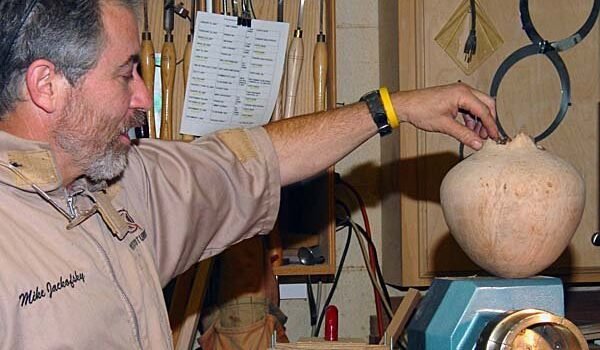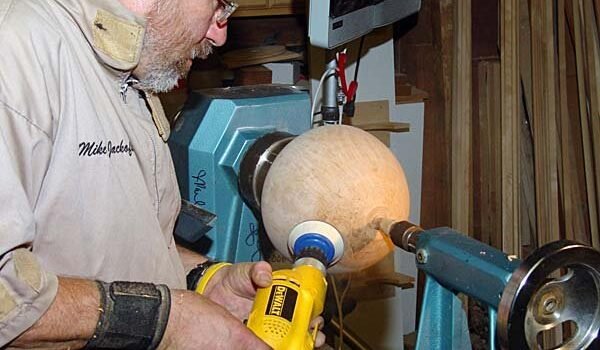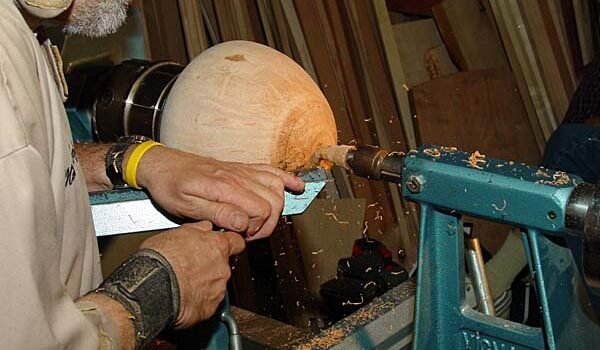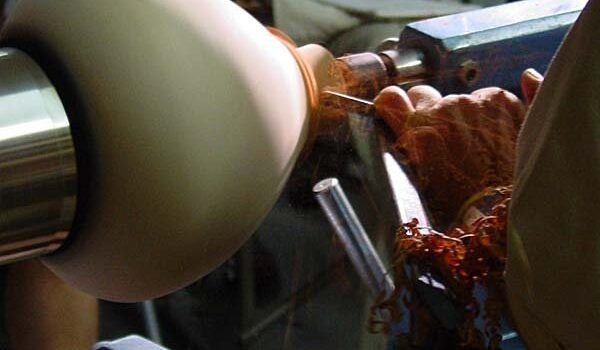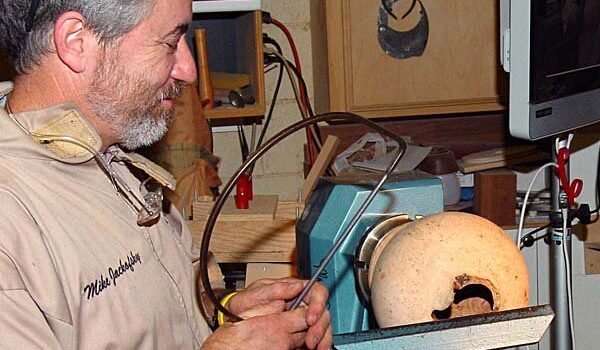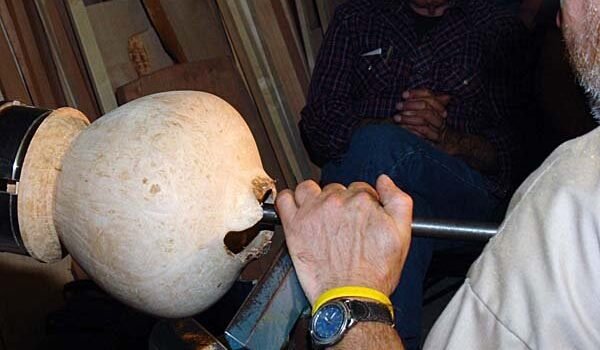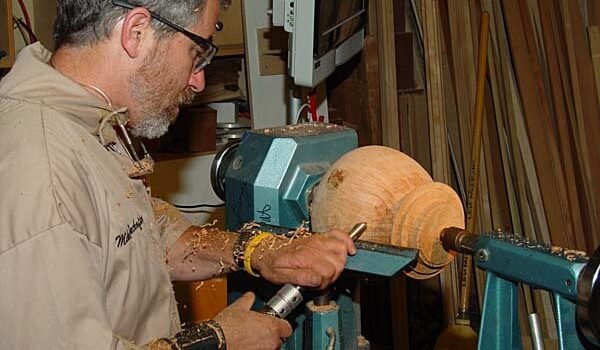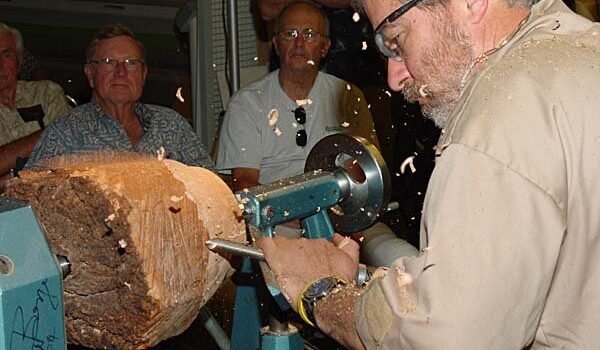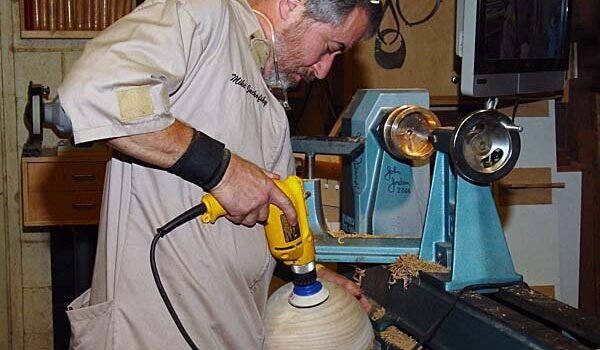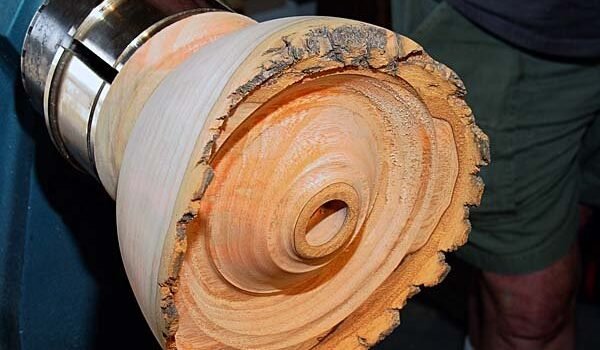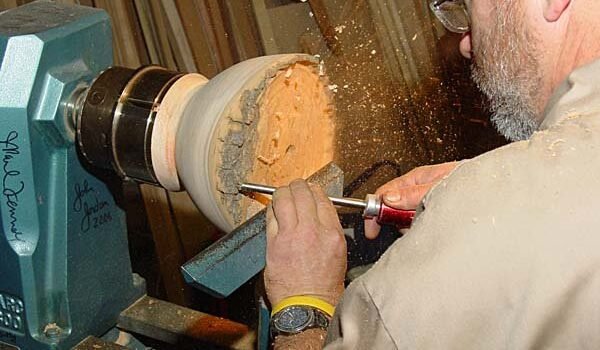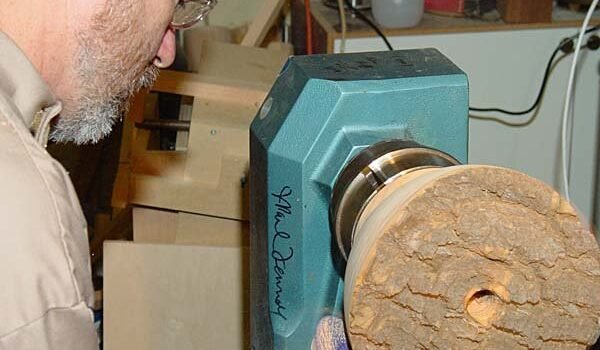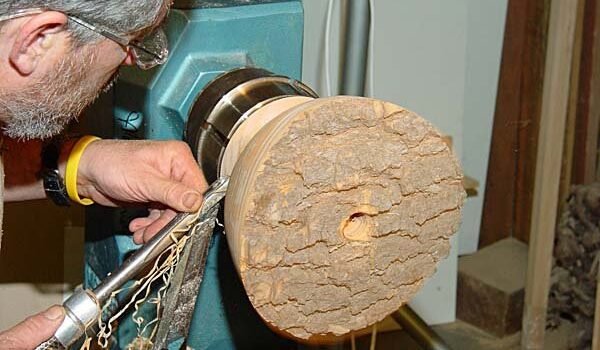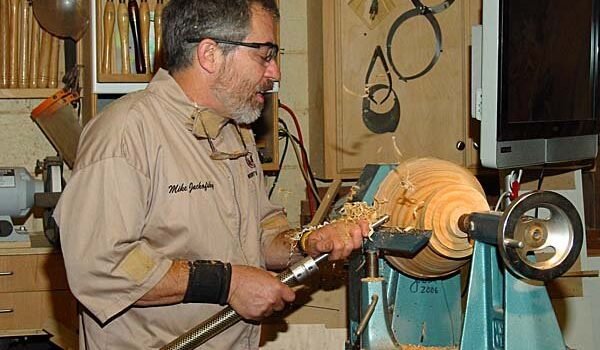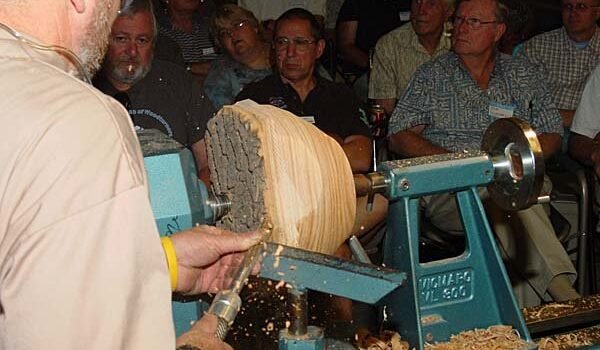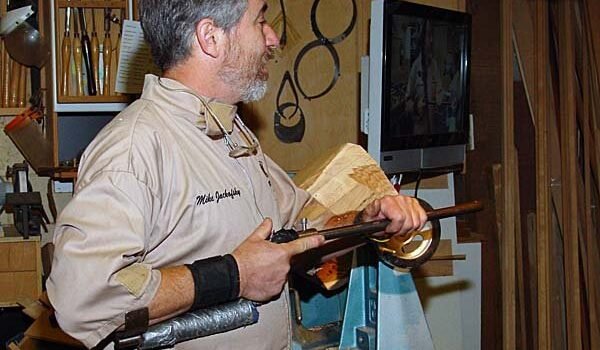Our featured demonstrator for the August 25th meeting is Mike Jackofsky. He comes from Harmony Grove, California. Mike gave up his law practice seven years ago to devote full time to his woodturning. Mike specializes in hollow forms, but he also turns thin, natural-edge, open bowls, and off-balance asymmetrical pieces, including hollow forms with wings and sculptural turnings. Most of his pieces are made from unique burls. Mike has demonstrated at the 2007 AAW in Portland. He also teaches at the Craft school in Provo, UT. His work is featured at the Sam Maloof Historical Residence and Museum in Alta Loma, CA, as well as the Mingei International Museum in San Diego, CA. You can see Mike’s work on his web siteWWW.MIKEJACKOFSKY.COM. — Joe Levy, Program Chair
For this all-day special demo RESERVATIONS are necessary. If you plan to attend email your reservation immediately to Ron Lindsay at RSVP@channelislandswoodturners.org and mail your check to him: $35 for members and $45 for guests by August 17th. After that date if there is still room neighboring woodturning clubs will be invited to attend. Friends of CIW who read this website may reserve now. Don’t wait to send in your reservation! Lunch is included.
The July 29th meeting featured our meeting-site host, custom cabinet maker and woodturner Levi Mize. Harvey Paskowitz writes: Levi set up an EXCEL spreadsheet to calculate router angles for building segmented cylinders. He will send copy to Ron who will distribute it to the membership. He will also include plans for the fixture that he designed. Levi then demonstrated how to assemble the cylinder, install the routing fixture and cut the flutes with a plunge router. He recommended screwing the end piece to each stave for safety. Thanks Levi!
Our August 25, 2007 meeting featured an all day demo with Mike Jackofsky. Mike comes from Harmony Grove, California, where seven years ago he gave up his law practice to devote his full attention to his woodturning. Mike specializes in hollow forms, most of which are natural edge pieces made from unique burls, but he also turns thin natural-edge open bowls, and off-balance asymmetrical pieces. Mike belongs to the San Diego Woodturners. Today he demonstrated turning a basic top, an open natural edge bowl and a natural edge hollow form, with tips and insights along the way.
TOP
Mike first showed us how he turns a basic top (his club also turns tops for their local county fair; they charge $5 to $10 for the tops and donate the proceeds to Toys for Tots). Mike turns tops with a bowl gouge. His preferred grind for a bowl gouge is 40o angle with a moderate swept back profile. After turning, chattering, and coloring a top he finishes it with a wax stick while still on the lathe.
OPEN NATURAL EDGE BOWL
Mike often chooses burls for his turnings. He stated that he ordinarily lets them season under a tarp for about nine months before cutting, at this point the burl will not be completely dry. When Mike chooses a piece of burl or wood to turn, he looks at the character of that particular piece of wood, such as grain, inclusions and defective areas deciding on his design options and goals for that piece. This helps him decide how to orient the piece in the lathe.
Mike turned a bowl using most of the techniques he uses for hollow forms so that we could actually see some of the inside cuts he uses. He begins by drilling a 1/2” to 1” dia. hole through the bark with a spade bit. This allows the spur drive to anchor into solid wood (this is where the opening will be when turning a hollow form). He usually starts with a large piece of burl (most often a square block) and is willing to waste wood knowing that once he begins to turn the character of the burl may change. This way he can reorient the piece in the tail stock (up or down) if he finds an area he wants to use: including or excluding certain qualities or defects; this gives him more freedom for design opportunities.
Notes:
Mike is an aggressive turner and gave us some insight into his stance and grip that allow him to turn for extended periods of time. Mike uses a three-finger grip on his tools, as you would a sword or golf club, not using the thumb and forefinger. He states this grip allow him to turn longer with less fatigue. The tool rests between the last three fingers and the palm of his hand. The grip is firm, with a looser grip for shear cutting.
- He uses body motion keeping the tool close to his body. Feet apart and knees slightly bent.
- If he needs to move the tool away from his body he tries to keep the handle under his forearm.
- He tries to change his grip position, sometimes on the top of the handle instead of the bottom.
- Mike believes that all lathes perform better if they are bolted to the floor. His personal lathe is a short bed lathe, it allows him to move easily around the lathe and stand at the end of the bed to reach into bowl and hollow forms without moving the tools away from his body.
Tool notes:
Mike used a variety of tools during his demonstration. They are listed here for easy reference.
- Bowl gouges: His preferred grind for a bowl gouge is 40o angle with a moderate swept back.
- Mike uses a Vicmarc Chuck with deep jaws (either Vicmarc shark or cup jaws)
- Dennis Stuart Arm Brace Handle (Mike did not like this handle until he changed to the three finger grip.
- Sorby multi tip tool hollowing tools (straight or bent) with the short handle removed and replaced with a long handle. The tool has a flat edge along the shank for help with controlling rotational forces.
- Hosaluk Handles: Mike says this is one of his favorite handles. The handle is double ended to accept 1/2” and 5/8” diameter blades with an adapter available for 3/8” blade. The handle is aluminum covered with rubber. Mike also likes Kelton handles.
- Kelton hollowing tools: Mike suggests Kelton 1/2” hollowing tools for beginners.
- Mike uses a 75o angle on all of his hollowing and scraping tools.
- Dennis Stuart cutting (hollowing) tip (HSS)
- Carbide cutting (hollowing) tip
Mike tries to turn his outside shape (with a bowl gouge) while still between centers (he feels he can be more aggressive this way and it is safer. While between centers Mike doesn’t lock down the tail stock barrel, he tightens the barrel frequently as he turns the outside of a piece. The he creates a tenon (Mike says don’t forget to measure tenon and cut appropriately for the jaws you are using whether straight or dovetailed) leaving a small piece on the bottom approximately 1” diameter and 1/2” long (button). Mike uses deep jaws so the tenon and button will fit in the jaws. This button allows the piece to be re-centered into the tailstock the same way when it is reversed turned for finishing the bottom. Before removing from between centers Mike cleans up the outside of the piece using the swept-back wing of a large bowl gouge on its side as a shear cut.
Mike chucks the piece using the deep jaws. He decides where he wants the bottom of the piece to be then using a concrete drill bit in a turning tool handle he drills into the center where the spur drive was seated to the desired depth. Before drilling he cuts a V notch into the opening to center the drill (this is how he would start the inside of a hollow form). Before hollowing he sands the out side of the piece, he will often sand with both the lathe and his drill in reverse. He has found this will help to sand out defects like tool marks (He is also trying a new ceramic grit sand paper and still is deciding how well he likes it).
Mike says the initial cut in a natural edge is the most important. The bowl gouge is held so that the bevel is at 90 degrees to the wood and cuts straight into the natural edge front to avoid damaging the edge that will show in the final piece.
Mike used the open bowl to show how he would start a hollow form. He cut from the drilled hole going toward the outside using the Sorby multi tip tool. He says to cut at the center, with the tool rest set slightly high so that you are coming slightly down to cut at the center. The hollowing of the inside of the bowl was finished the conventional way with a bowl gouge. He made his final cuts using a small bowl gouge (with an aluminum handle) to finish the inside. Note: when hollowing Mike does about half of the depth and then does his finishing cuts before continuing farther into the bowl.
NATURAL EDGE HOLLOW FORM – BLIND TURNING
Mikes Hollowing tips:
- When using hollowing tools the tip of the cutting edge should be aligned with the axis of the shaft to minimize rotational forces.
- When using a bent tool the tool rest needs to be on the straight part of the shaft, never on the curved part of the shaft.
- Mike uses a 75o angle on all of his hollowing and scraping tools.
- Try not to look into the form, learn to feel the cut.
- Mike re-taps his cutting tips with a larger bore so tips are more secure.
Mike demonstrated the steps he takes in creating a hollow form:
Pre-steps: Mike decides how he wants to orient the piece of wood or burl in the lathe and where the opening will be.
- Drill a 1/2” to 1” dia. hole through the bark with a spade bit (the diameter of this hole in usually the size of the opening in the hollow form. Place piece between centers and turn to get piece in balance.
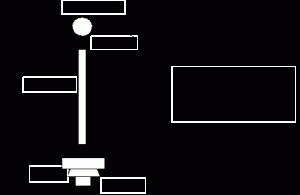
- Once balanced Mike pictures the shape be wants and looks again at the character of the wood and decides if he wants to reorient the piece on the lathe.
- The basic shape is turned.
- Cuts the tenon with the button (described in the bowl section).
- Chucks up the piece and balances out the piece again.
- The final outside shape is turned. NOTE: at this point the chuck and the piece can be taken screwed of off the head stock and set upright so you can view your piece in the correct orientation to make sure you are happy with the shape. At this point the outside can still be changed, once you start hollowing out the inside the outside can not be changed.
- Decide where the bottom of the piece is going to be. Create a V notch (see drawing) and drill down the center.
- Sand the outside of the piece.
- Start hollowing. The beginning hollowing will decide the thickness of the piece.
- Hollow out the first half of the form to about 1/2” thick using bent hollowing tool (Sorby multi tip or other). Note: Mike is trying a new carbide cutting tip, it is more aggressive and removes more material quickly, but does not have as clean of a cut as HSS. Mike used an air compressor to remove the shavings from the inside of the piece. He says to do this quickly; the air will cause the piece to start drying faster (see # 12).
- Finishes last few inches with the straight Sorby tool.
- Sands only part of the inside top half, to about how far one can feel with their fingers. Note: when the top half is finished and to its final thickness the top half is starting to dry as you work on the bottom half. Once you reach this point you must finish hollowing the piece. Coming back to it later may cause problems such as cracking.
- Mike starts hollowing out the bottom with the carbide tip.
- Once the majority of the material was removed, he changed to the Dennis Stuart HSS tip (less aggressive) to finish the inside.
- Do the final sanding of the inside and top (sand outside if necessary).
- Remove from chuck and reverse the piece. Re-chuck the top of the piece by placing into the jaws of the chuck as a jam-chuck using something like a mouse pad for protection. Bring up the tail stock and place in the center of the button. Be careful to tighten up the tailstock, but not too tight. Rotate the piece by hand to check for clearance. Turn lathe down to slow and turn on making sure that the piece is secure and safe.
- Turn away most of the tenon and shape the bottom. Check and measure frequently.
- Decide where the bottom is going to be and sneak up on it (small cuts; don’t want to go through the bottom after all of that work). Remember to under cut the base so it will set on the edge of the base.
- Saw off what is left of the tenon and sand.
Mike places the turned hollow forms in a plastic bag for 1 month. He then sands them with a palm sander keeping it moving at all times. He finishes the form with 3 coats of Tung oil making sure each coat is dry before applying the next. Finally he buffs it with Tripoli. No finish is used on the inside.


